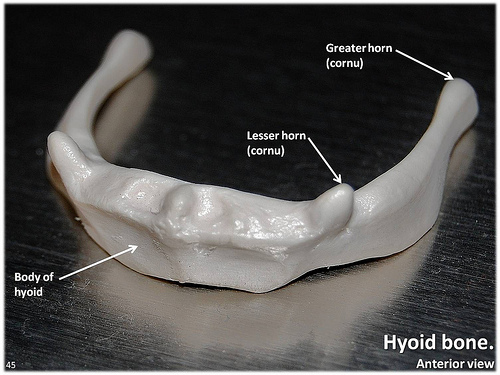There is a bone that not many know of, there is a bone that is not attached to other bones, only to muscle, and this bone gives us the ability to speak. You would think the part of our bodies that would give us the ability to speak would be a muscle; such as the tongue. But this bone is what helps control the actions of the tongue, pharynx (cavity behind the nose and mouth which connects them to the esophagus), larynx (the hollow muscular organ forming an air passage to the lungs and holding the vocal cords in humans and other mammals; the voice box), and even the mandible (the jaw). Without this bone we would not have the capability to speak. The name of this unknown bone is the hyoid.
Not to be confused with the thyroid, which is at the base of the neck, while the hyoid is as the base of the mandible. At birth, we humans have the hyoid slightly higher (and in it being higher, so is the larynx), which is why babies can breath and drink at the same time. Around three months, the larynx drops, and even though this would increase the probability of choking, it also highly increases the ability for speech. But this is not the last time the larynx will “drop;” in human males around puberty it slightly drops one more time, which gives them a deeper voice than human females. “No other animal has a larynx low enough to produce sounds as complex as our ancient ancestors did and as we do today, including our close relatives the chimpanzees, whose hyoid bone sits just a smidge too high to do anything but hoot and grunt.”
Now just because our closest living cousins do not have a low larynx, that does not mean our evolutionary ancestors and cousins did not. The first of our ancestors that is believed to be able to speak was the Homo heidelbergensis, who is “believed to be the related to both modern humans and Neanderthals.” Yes, that is right, according to fossil records we have of Neanderthals, it is likely they were able to speak. This is still a “theory,” but it is exciting to think how they would have sounded, what they would have talked about.
However amazing the hyoid presents itself, it also helps us in solving crimes. How? Well, first I must explain what the hyoid Is like. It is shaped like a U (image below), and it is not fully solid during adolescence, but once it is fused (mind you, not all hyoids fuse), it is very hard to break. Which is why in murder cases if the hyoid is broken, the primary cause of death would be strangulation.
Not to be confused with the thyroid, which is at the base of the neck, while the hyoid is as the base of the mandible. At birth, we humans have the hyoid slightly higher (and in it being higher, so is the larynx), which is why babies can breath and drink at the same time. Around three months, the larynx drops, and even though this would increase the probability of choking, it also highly increases the ability for speech. But this is not the last time the larynx will “drop;” in human males around puberty it slightly drops one more time, which gives them a deeper voice than human females. “No other animal has a larynx low enough to produce sounds as complex as our ancient ancestors did and as we do today, including our close relatives the chimpanzees, whose hyoid bone sits just a smidge too high to do anything but hoot and grunt.”
Now just because our closest living cousins do not have a low larynx, that does not mean our evolutionary ancestors and cousins did not. The first of our ancestors that is believed to be able to speak was the Homo heidelbergensis, who is “believed to be the related to both modern humans and Neanderthals.” Yes, that is right, according to fossil records we have of Neanderthals, it is likely they were able to speak. This is still a “theory,” but it is exciting to think how they would have sounded, what they would have talked about.
However amazing the hyoid presents itself, it also helps us in solving crimes. How? Well, first I must explain what the hyoid Is like. It is shaped like a U (image below), and it is not fully solid during adolescence, but once it is fused (mind you, not all hyoids fuse), it is very hard to break. Which is why in murder cases if the hyoid is broken, the primary cause of death would be strangulation.
So ends another small fun fact for Fun Fact Friday. Again, if you have an itching to get to the bottom of a small fact that has been festering in your mind, or if you have a blog topic you would like me to cover, or if you would just like to express your thoughts on this first Fun Fact Friday, please feel free to comment below.

 RSS Feed
RSS Feed
